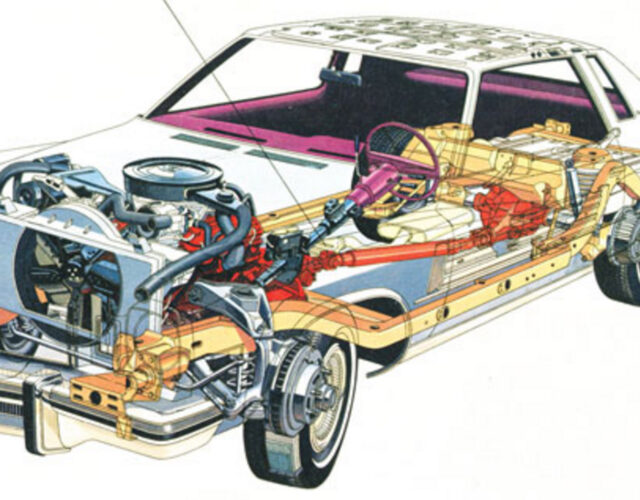In February 2014, in the early hours of a cold Chicago morning, two men in a Jeep Liberty pulled up next to a parked minivan. One of the men got out of the car with an electric saw in hand while the other watched for police. The thief didn’t bother with the radio, didn’t even break a window. Instead he lay on his back and slid under the van. His target? The van’s catalytic converter, a small metal box along the exhaust pipe. He cut through the clamps holding the catalytic converter in place and pulled it away. A few minutes later a police car approached. Erik Gholson and Marshawn Green, the two thieves, fled in the Jeep but were arrested after a short chase. Police officers found six stolen catalytic converters in their truck along with a stash of saw blades.
Criminals like these are increasingly targeting the devices under cars instead of the valuables inside. Catalytic converters contain small amounts of expensive metals, such as platinum, palladium, and rhodium. These metals speed up the reactions of car exhaust gases, such as carbon monoxide and nitrogen oxides, and convert them to less directly harmful gases. As the price of these metals has risen, so have thefts of catalytic converters. In 1986 platinum cost a little over $800 per ounce (adjusting for inflation). Today platinum is almost $1,400 per ounce. Stolen converters can be sold to scrap yards for as much as $150. Drivers pay much more to replace one.
Eugene Houdry, the inventor of the catalytic converter, likely never imagined his creation as a target for criminal conspiracies. Houdry had invented catalytic cracking in the 1930s, a process that produced more and higher-octane gasoline from crude oil and one that gave the Allied military effort a vital edge during World War II. In the early 1950s Houdry turned his attention to the toxic automobile emissions choking Los Angeles and other cities. Both the black smog and the stink of car exhaust worried him. Houdry’s solution was a metal casing whose insides were coated with a catalyst, usually platinum, which sped up the oxidation of exhaust fumes. An article from the June 1955 issue of Popular Science colorfully describes this process:
But there was one significant problem: Houdry’s invention was hamstrung by the leaded gasoline then in use. While tetraethyl lead boosted a car’s performance, the lead also coated the catalyst inside the converter, preventing exhaust gases from coming into contact with the metal. So Houdry shifted to building systems for indoor forklifts and industrial chimneys instead.
In response to growing public concern about air pollution, Congress passed the Clean Air Act of 1970, which created air-quality standards and led to a requirement that all cars have catalytic converters. This requirement forced the removal of lead from gasoline. Getting rid of lead was no simple task: lead-free gasoline requires extensive reprocessing to produce an octane level that can match its leaded counterpart. (The higher the octane level of a fuel, the less likely an engine will “knock.”)
Three years later the recently created Environmental Protection Agency mandated that all cars beginning with model year 1975 be outfitted with catalytic converters to meet emission standards. Thousands of researchers were put to work by catalyst companies and car manufacturers. General Motors alone, at the time the country’s largest carmaker, put 5,000 people to work on catalytic converters.
Automobile catalytic converters were soon adapted to nullify three types of gases (nitrogen oxides, hydrocarbons, and carbon monoxide); these next-generation devices were dubbed three-way converters. The honeycomb structure inside the metal casing vastly increased the surface area of the catalyst that came into contact with the fumes. Today’s three-way devices can convert as much as 98% of these gases into their less harmful counterparts.
Leaded gasoline—for older cars—and unleaded gasoline were sold side by side until amendments to the Clean Air Act made the sale and use of all leaded gasoline in cars illegal beginning in 1995. Thanks to the work of Houdry and his successors, virtually every fuel-burning car sold in the United States has a catalytic converter. Unfortunately, their rising cost makes every car a potential target for thieves. Some companies now sell special devices to protect catalytic converters. Consider the Catclamp, which surrounds a converter with “aircraft grade wire rope,” or the Catlock, which attaches the converter to the car’s frame with a large metal harness.
“The catalytic converter influenced life in the whole world. . . . It is one of the greatest technical successes of chemical work, ever.”
—L. Louis Hegedus, a retired chemical engineer and a member of CHF’s Heritage Council. His first job after moving to the United States was developing catalytic converters for General Motors’ 1975 model-year automobiles. Later Hegedus went on to direct research at W. R. Grace and Arkema.
“[The catalytic converter was] a truly remarkable convergence of chemical engineering, of catalysts that are affordable to put on vehicles, and public policy encouraging the installation of those catalysts on every vehicle in the nation.”
—Ronald C. Cohen, a professor of chemistry at the University of California, Berkeley, and director of the Berkeley Atmospheric Sciences Center, remarking on the role of catalytic converters in improving air quality. Cohen’s research focuses on detecting and tracking the effects of pollutants in the atmosphere.
These quotes come from the Science History Institute’s Center for Oral History.




